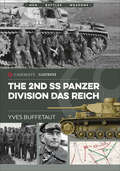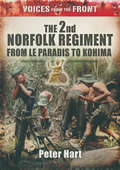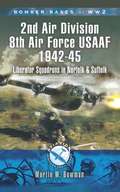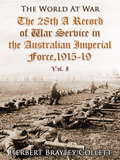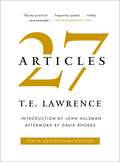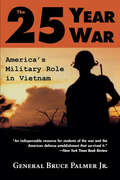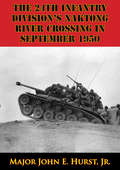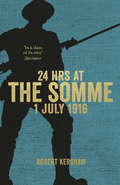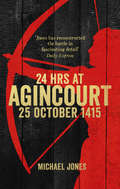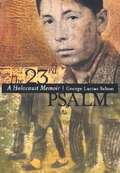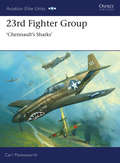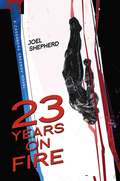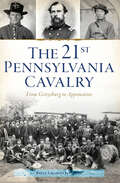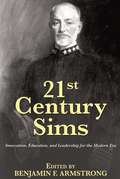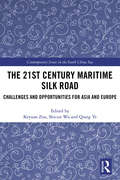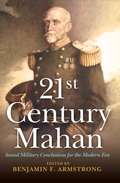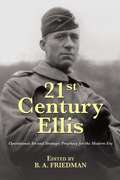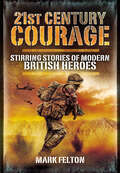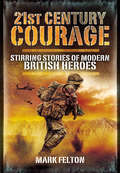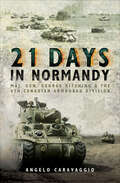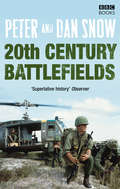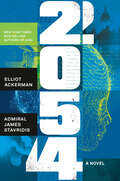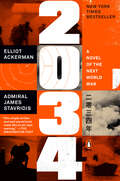- Table View
- List View
The 2nd SS Panzer Division Das Reich (Casemate Illustrated)
by Yves BuffetautThe Das Reich Division was the most infamous units of the Waffen-SS. Hitler's Schutzstaffel (SS) units were originally paramilitary formations raised to protect the members of the Nazi party, and the Waffen-SS (the armed SS) was founded in 1934 as the SS-Verfügungstruppe. In 1939 the SS-Verfügungstruppe was placed under the operational command of the OKH. During the invasion of Poland the unit fought as a mobile infantry regiment. There were doubts about the unit's effectiveness, but Hitler ordered it be allowed to expand and form its own divisions, but under the command of the army. In 1940 the SS-Verfügungs-Division participated in the invasion of the Netherlands and France. After the Battle of France the SS-VT was officially renamed the Waffen-SS, and in 1941, the Verfügungs-Division was renamed Reich, later Das Reich.In 1941 Das Reich took part in the invasion of Yugoslavia, where its men accepted the surrender of Belgrade. In Barbarossa, Das Reich fought with Army Group Center, in the spearhead of Operation Typhoon and taking part in the battle of Moscow, by which time it had lost 60 percent of its combat strength. It was pulled off the front in mid-1942 and sent to refit as a panzer-grenadier division. Returning to the Eastern Front, Das Reich took part in the fighting around Kharkov and Kursk. Late in the year it was designated a panzer division. In 1944, the unit was stationed in southern France when the Allies landed in Normandy. The following days saw the division commit atrocities, hanging 100 local men in the town of Tulles in reprisal for German losses, and massacring 642 French civilians in Oradour-sur-Glane, allegedly in retaliation for partisan activity in the area. Later in the Normandy fighting Das Reich was encircled in the Roncey pocket by US 2nd Armored Division, losing most of their armored equipment. Das Reich surrendered in May 1945.
The 2nd Norfolk Regiment: From Le Paradis to Kohima (Voices from the Front)
by Peter HartThe Second World War is vanishing into the pages of history. The veterans were once all around us, but their numbers are fast diminishing. While still in their prime many recorded their memories with Peter Hart for the Imperial War Museum. As these old soldiers now fade away their voices from the front are still strong with a rare power to bring the horrors of war back to vivid life. The 2nd Norfolk Regiment were a proud old regular battalion honed in the pre-war traditions of spit and polish at their Britannia Barracks in Norwich. Sent to France they sold their lives to gain time for the retreat to Dunkirk when surrounded by an SS Division at Le Paradis in May 1940. Over 100 of the survivors would be brutally massacred. Back in England they reformed from ordinary drafts of men called up from all over the country. A new battalion was born. Sent to India they met the Japanese head on in the bloody fight for Kohima against the Imperial Japanese Army. As the fighting raged in the jungle the Norfolks were once again right at the very sharp end of modern war. This is their story.
2nd Air Division Air Force USAAF 1942-45: Liberator Squadrons in Norfolk and Suffolk (Bomber Bases of WW2)
by Martin W. BowmanAs part of the AHT series, the airfields and interest in this book are concentrated in a particular area—in this case Norfolk and Suffolk. The Second Air Division's first bombing mission was flown on November 7, 1942; the last on April 25, 1945. A total of 95, 948 sorties were flown in 493 operational missions by the division's B-24s, dropping 199,883 tons of bombs. Targets attacked ranged from Norway in the north, as far east as Poland and Romania, while several Mediterranean countries were reached from temporary bases in North Africa. Six 2nd Air Division groups received special presidential citations for outstanding actions and five airmen received the Medal of Honor (highest US award for bravery), four posthumously. In combat the 2nd Air Division gunners claimed 1,079 enemy fighters destroyed against losses of 1,458 B-24s missing in action and many others lost in accidents. This book looks at the history and personalities associated with each base, what remains today and explores the favourite local wartime haunts where aircrew and ground crew would go.
The 28th: A Record Of War Service In The Australian Imperial Force, 1915-19, Vol. I, Egypt, Gallipoli, Lemnos Island, Sinai Peninsula (The World At War #1)
by Herbert Brayley CollettA comprehensive description of Australia's mounted horse troops involvement in the First World War. From the formation of the 28th brigade light horse, through to their battles overseas.
27 Articles
by David Rhodes John Hulsman T. E. Lawrence27 Articles is Lawrence of Arabia’s classic set of guidelines on military leadership in the Middle East. The 100th anniversary edition features a new introduction by foreign policy expert John Hulsman and a new afterword from CBS News President David Rhodes, addressing the articles’ lasting lessons.In 1916, T.E. Lawrence was deployed to the Arabian Peninsula to aid with the Arab Revolt against the Ottoman Empire. It was the middle of World War I and the British command was throwing its weight behind the long-rebellious southern territories of the Ottoman Empire. Lawrence had extraordinary success fighting alongside the coalition of Arab revolutionaries, and his story has since become legend. Worried that Lawrence would die on the battlefield and that his knowledge would vanish with him, British command asked Lawrence to write out a series of guidelines on his own tactics and teachings. 27 Articles, the text of Lawrence’s guidelines, has become required reading for military leaders. Lawrence’s deployment was the West’s first modern involvement in war in the Middle East, and his campaign held myriad lessons for future generations. Despite being a century old, the articles are deeply prescient on the challenges America has faced in its wars in Iraq and Afghanistan. Terse and to the point, Lawrence’s articles begin on the battlefield but their value extends well beyond, into the fields of management, leadership, and business. On the 100th anniversary of 27 Articles’ original publication, foreign policy John Hulsman and CBS News President David Rhodes now speak to the articles’ ongoing importance, outlining the wisdom they hold for political, military, and business leaders on into the future.
The 25-Year War: America's Military Role in Vietnam
by Bruce Palmer Jr.On April 30, 1975, Saigon and the government of South Vietnam fell to the communist regime of North Vietnam, ending -- for American military forces -- exactly twenty-five year of courageous but unavailing struggle. This is not the story of how America became embroiled in a conflict in a small country half-way around the globe, nor of why our armed forces remained there so long after the futility of our efforts became obvious to many. It is the story of what went wrong there militarily, and why. The author is a professional soldier who experienced the Vietnam war in the field and in the highest command echelons. General Palmer's insights into the key events and decisions that shaped American's military role in Vietnam are uncommonly perceptive. America's most serious error, he believes, was committing its armed forces to a war in which neither political nor military goals were ever fully articulated by our civilian leaders. Our armed forces, lacking clear objectives, failed to develop an appropriate strategy, instead relinquishing the offensive to Hanoi. Yet an achievable strategy could have been devised, Palmer believes. Moreover, our South Vietnamese allies could have been bolstered by appropriate aid but were instead overwhelmed by the massive American military presence. Compounding these errors were the flawed civilian and military chains of command. The result was defeat for America and disaster for South Vietnam. General Palmer presents here an insider's history of the war and an astute critique of America's military strengths and successes as well as its weaknesses and failures.
25 Women Who Protected Their Country (Daring Women)
by Emma Bernay Emma Carlson BerneDiscover 25 women who served in the military and accomplished great feats of strength and bravery. Whether through medicine, espionage, journalism, or combat, these 25 women show what it takes to be a hero.
The 24th Infantry Division’s Naktong River Crossing In September 1950
by Major John E. Hurst Jr.It is the story of the 24th Division's Naktong River crossing with which this thesis is concerned. In writing an account of the 24th Division's crossing, the historian cannot detract from the praise due the officers and men of the division who sacrificed so much in crossing the Naktong River barrier; neither can he omit the roles played by the non-divisional troops who supported the crossing. Likewise, he should not disregard the adjacent units' actions that materially assisted the 24th Division in accomplishing its mission. For these reasons, I have chosen to relate the 5th Regimental Combat Team's attack on Waegwan and the 5th Cavalry Regiment's attack to secure the Taegu-Waegwan highway. Both of these operations were vital to the 24th Division's success; the first cleared the enemy from the east bank of the river and the second secured a main supply route for the division.
24 Hours at the Somme: 1 July 1916
by Robert KershawThe first day of the Somme has had more of a widespread emotional impact on the psyche of the British public than any other battle in history. Now, 100 years later, Robert Kershaw attempts to understand the carnage, using the voices of the British and German soldiers who lived through that awful day.In the early hours of 1 July 1916, the British General staff placed its faith in patriotism and guts, believing that one ‘Big Push’ would bring on the end of the Great War. By sunset, there were 57,470 men – more than half the size of the present-day British Army – who lay dead, missing or wounded. On that day hope died.Juxtaposing the British trench view against that from the German parapet, Kershaw draws on eyewitness accounts, memories and letters to expose the true horror of that day. Amongst the mud, gore and stench of death, there are also stories of humanity and resilience, of all-embracing comradeship and gritty patriotic British spirit. However it was this very emotion which ultimately caused thousands of young men to sacrifice themselves on the Somme.
24 Hours at Agincourt
by Michael JonesAgincourt was an astonishing clash of arms, a pivotal moment in the Hundred Years War and the history of warfare in general.King Henry V’s exhausted troops were preparing for certain defeat as they faced a far larger French army. What was to take place in the following 24 hours, it seemed only the miraculous intervention of God could explain.Interlacing eyewitness accounts, background chronicle and documentary sources with a new interpretation of the battle’s onset, acclaimed military historian Michael Jones takes the reader into the heart of this extraordinary feat of arms.
The 23rd Psalm: A Holocaust Memoir
by George Lucius Salton Anna Salton EisenAfter a half century, the author who now lives in Florida returned to his hometown in Poland to find that "... the wall that I have carefully built between the past and present has crumbled..." Salton (nee: Saltzman) relates surviving ten concentration camps as an adolescent and liberation by American soldiers, including Jewish ones to his astonishment.
23rd Fighter Group
by Carl Molesworth Jim LaurierStaffed with inexperienced USAAF pilots and led by a handful of seasoned veterans of the American Volunteer Group (AVG), the 23rd FG was formed in the field at Kunming, in China, on July 4, 1942 and flew combat missions that same day. The group's three squadrons - the 74th, 75th and 76th Fighter Squadrons - were initially equipped with war-weary P-40s handed down from the AVG. These were supplemented by the attached 16th FS, flying new P-40Es, and all squadrons adorned the noses of their airplanes with fearsome and iconic sharksmouth designs.The 23rd FG fought a guerrilla war against the Japanese, steadily moving pilots and aircraft from one remote air base to another to keep the enemy off balance. Because China could only be supplied by air from India, there were constant shortages of aircraft, fuel and ammunition with which to contend. The 23rd FG met these challenges head-on and by the end of the war its pilots had compiled a score of 594 aerial victories and nearly 400 ground kills. Among the 47 aces who flew in the 23rd were colorful characters such as David L 'Tex' Hill, Robert L 'Bob' Scott and Clinton D 'Casey'. The human cost was high, however - 126 pilots lost their lives in China while serving in the 23rd.
23 Years on Fire: A Cassandra Kresnov Novel (Cassandra Kresnov Ser.)
by Joel ShepherdCassandra Kresnov--a highly advanced hunter-killer android--returns to face down a rogue government's plot to eliminate free will. Commander Cassandra Kresnov has her hands full. She must lead an assault against the Federation world of Pyeongwha, where a terrible sociological phenomenon has unleashed hell against the civilian population. Then she faces the threat from a portion of League space known as New Torah, in which a ruthless regime of surviving corporations are building new synthetic soldiers but taking the technology in alarming directions. On the Torahn world of Pantala, Sandy encounters betrayal, crisis, and conspiracy on a scale previously unimaginable. Most challenging of all, she also meets three young street kids who stir emotions in her she didn't think she was capable of. Can the Federation's most lethal killer afford unexpected sentiment? What will be the cost if she is forced to choose between them and her mission, not only to her cause, but to her soul?
The 21st Pennsylvania Cavalry: From Gettysburg to Appomattox (Civil War Series)
by Britt Charles IsenbergHailing from the south-central region of the state, the 21st Pennsylvania Cavalry was forged during the Gettysburg Campaign in the third summer of the Civil War. Its charismatic officers included William H. Boyd and Oliver B. Knowles, who had honed their fighting prowess earlier in the war against fearsome Confederate tacticians John Mosby and John Imboden. The regiment's war record was dynamic and arduous, including service under Meade and Grant at Cold Harbor as infantry and making the last charge at Appomattox Court House as cavalry. After the war, veterans continued to honor their comrades, and two monuments were erected at Gettysburg to commemorate the regiment's proud service. Author Britt Charles Isenberg chronicles the gritty history of the 21st Pennsylvania Cavalry.
21st Century Sims
by Edited by Benjamin F. ArmstrongFor more than two decades at the beginning of the 20th century William S. Sims was at the forefront of naval affairs. From the revolution in naval gunnery that he led as a junior officer, to his advocacy for the Dreadnaught style all-big-gun battleship, to his development of torpedo boat and destroyer operations, he was a central figure in helping to prepare the U. S. Navy for World War I. During the war he served as the senior naval commander in Europe and was instrumental in the establishment of the convoy system that won the Battle of the Atlantic. Following the war his leadership as President of the Naval War College established the foundations of the creative and innovative Navy that would develop the operating concepts for submarines and aircraft carriers which would lead to success in World War II. Despite his dramatic impact on the U. S. Navy in the first half of the 20th century, Sims is a relatively unknown figure today. Overshadowed in our memory by the World War II generation of strategic Admirals, like Chester Nimitz and Raymond Spruance, he receives little attention from historians or professional naval officers. Despite the fact that he won a Pulitzer Prize for history, hardly anyone reads the books or articles he left as his legacy. This collection of six essays written by Sims illustrates why his thinking and leadership are relevant to the challenges faced in the 21st century. From the perils of military conservatism, to the responsibilities of the professional officer, to military downsizing and reform, he helped lay the foundations of the modern Navy. Armstrong’s introductions and analysis of these essays links them directly to the issues of innovation, professional education, and leadership that are as important at the start of this century as they were at the start of the last.
The 21st Century Maritime Silk Road: Challenges and Opportunities for Asia and Europe (Contemporary Issues in the South China Sea)
by Keyuan Zou Shicun Wu Qiang YeThis book explores the opportunities and challenges that both Europe and Asia face under the framework of the 21st Century Maritime Silk Road Initiative. The 21st Century Maritime Silk Road Initiative (MSR Initiative), put forward by the Chinese government together with the Silk Road Economic Belt, reflects China’s ambition and vision to shape the global economic and political order. The first step and priority under the MSR Initiative, according to documents issued by China, is to build three ‘Blue Economic Passages’ linking China with the rest of the world at sea, two of which will connect China with Europe. This initiative, however, still faces enormous challenges of geopolitical suspicion and security risks. This book seeks to assess these risks and their causes for the cooperation between the Eurasian countries under the framework of MSR and puts forward suggestions to deal with these risks in the interdisciplinary perspectives of international relations and international law. Featuring a global team of contributors, this book will be of much interest to students of Asian politics, maritime security, international law and international relations.
21st Century Mahan
by Benjamin ArmstrongAlfred Thayer Mahan's The Influence of Seapower upon History is well known to students of naval history and strategy, but his other writings are often dismissed as irrelevant to today's problems. This collection of five of Mahan's essays, along with Benjamin Armstrong's informative introductions, illustrates why Mahan's work remains relevant to the 21st century and how it can help develop our strategic thinking. People misunderstand Mahan, the editor argues, because they have read only what others say about him, not what Mahan wrote himself. Armstrong's analysis is derived directly from Mahan's own writings. From the challenges of bureaucratic organization and the pit falls of staff duty, to the development of global strategy and fleet composition, to illustrations of effective combat leadership, Armstrong demonstrates that Mahan's ideas continue to provide today's readers with a solid foundation to address the challenges of a rapidly globalizing world.
21st Century Ellis
by Edited by B. A. FriedmanFor years, the Marine Corps has touted the prescience of Lieutenant Colonel "Pete” Ellis, USMC, who predicted in 1921 that the United States would fight Japan and how the Pacific Theater would be won. Now, for the first time, those predictions and other works by the "amphibious prophet” are available in print. Included is two works by Ellis on naval and amphibious operations, including Advanced Base Operations in Micronesia, the study of tactics and operations in the Pacific Ocean that the United States Navy and Marine Corps would use to win the war against Imperial Japan. Ellis describes the form and functions of a modern Marine Corps designed to win its Nation’s battles. Ellis’ ideas about how the Marine Corps should fight are still in use throughout the world today. Ellis’ ideas on amphibious operations are well known, but his ideas on counterinsurgency and conventional war have been overshadowed and forgotten. Ellis wrote two articles based on his warfighting experiences in the Philippines and as part of the American Expeditionary Force in Europe during World War I. These articles, last published in the early 1920’s, are both republished in this book and show Ellis as a prescient thinker who was ahead of his time. Ellis identifies concepts that the U. S. military struggles with even today, and that other thinkers would not identify for decades after Ellis’ death. Also included are six essays by the editor, introducing the ideas of Pete Ellis and putting them in a modern context. As the United States turns its focus to the Pacific, Ellis’ ideas can inform policymakers on the dynamics of strategy and warfare in the vast reaches of the Pacific Ocean. Edited by Captain B. A. Friedman, USMC, 21st Century Ellis reveals the strategic insights of Pete Ellis for then and now.
21st Century Courage: Stirring Stories of Modern British Heroes
by Mark FeltonThe book examines examples of outstanding courage exhibited by people living in modern Britain. These include British servicemen and servicewomen serving in Iraq and Afghanistan, police officers, and ordinary civilians in Britain and around the world. All of the cases cited have been awarded gallantry medals by the British government since 2000.The purpose of the book is to inspire modern British people. In the past, the heroes of Empire were well-known and respected, but since the Second World War people have tended to associate heroism with celebrity instead. We hear footballers and actors described as heroes, and this demeans the word, and the real heroes of modern British society. The generations that fought the First and Second World Wars have often been held up as the greatest generations of British people. This book shows Britons that the kind of grit, determination, courage and willingness to have a go exhibited by previous generations are as alive now as they ever were, and heroes can come from all walks of life and all ethnic groups in modern Britain.
21st Century Courage: Stirring Stories of Modern British Heroes
by Mark FeltonThe book examines examples of outstanding courage exhibited by people living in modern Britain. These include British servicemen and servicewomen serving in Iraq and Afghanistan, police officers, and ordinary civilians in Britain and around the world. All of the cases cited have been awarded gallantry medals by the British government since 2000.The purpose of the book is to inspire modern British people. In the past, the heroes of Empire were well-known and respected, but since the Second World War people have tended to associate heroism with celebrity instead. We hear footballers and actors described as heroes, and this demeans the word, and the real heroes of modern British society. The generations that fought the First and Second World Wars have often been held up as the greatest generations of British people. This book shows Britons that the kind of grit, determination, courage and willingness to have a go exhibited by previous generations are as alive now as they ever were, and heroes can come from all walks of life and all ethnic groups in modern Britain.
21 Days in Normandy: Maj. Gen. George Kitching & the 4th Canadian Armoured Division
by Angelo Caravaggio&“Right[s] some of the injustices done to the Canadians&” on their maligned actions during the Invasion of Normandy. &“An absorbing account&” (Firetrench). The Canadian Fourth Armoured Division crossed the Channel in July 1944 to support the invading forces and assist in the Allied attempts to break out of the Normandy beachhead. They were heavily engaged in Operation Totalize and Operation Tractable but have been criticized for their failure to close the &‘Falaise gap&’ and complete the entrapment of withdrawing German forces. Their commander, Major General George Kitching, was relieved of his command after just twenty-one days in action. Angelo Caravaggio reexamines the division&’s performance and particularly that of its leadership. Using new information, he establishes that, despite entering battle for the first time during one of the most challenging phases of Allied operations in August 1944, the 4th Armoured Division, under Kitching&’s leadership, proved resilient and adaptive in overcoming the volatile and unpredictable nature of warfare in Normandy. The combat operations of August 1944 transformed the division into a battle-hardened combat formation that would later distinguish itself through its ability to generate a sustained drive across France out of the chaos and destruction of the Normandy battles. &“The author uses new information to demonstrate the unit did show flexibility and adapted to the battlefield quickly, despite being thrown into battle during one of the Normandy Campaign&’s critical phases. His arguments are detailed and based upon in-depth research, and the book has many detailed maps to help the reader follow the action.&” —Warfare History Network
21 Army Group: Normandy To The Baltic [Illustrated Edition] (Memoirs Of Field Marshal Montgomery #1)
by Field Marshal Viscount Bernard Law Montgomery of Alamein KG GCB DSO PC[Illustrated with 46 highly detailed maps of the actions]Field Marshal Montgomery commanded the Eighth Army from 13th August 1942 until the 31st December 1943, and the 21st Army Group from 1st January 1944 until the German surrender on the 5th May, 1945. Whilst in command of the British Army of the Rhine, in occupation of Germany, shortly after the end of the Second World War Montgomery set out to record the exploits and victories of the troops under his command.Both this volume and its companion volume, El Alamein to the River Sangro, are superb examples of military history as presented by one of the greatest generals to command victorious armies in the field. The texts are taken from his personal war diaries and are distinguished by his incisive style. The whole strategy and course of these two campaigns are presented to the reader with great clarity and accuracy.In Normandy to the Baltic the Field Marshal unfolds that greater task -- the planning and implementation of the greatest invasion the world has ever known -- Operation Overlord. He describes the whole plan behind. D Day and the Battle of Normandy. He continues with the battle for Caen and the capture of Cherbourg, the closing of the Falaise Pocket and the crossing of the Seine--through into the Low Countries and the Battle of Arnhem and the famous Battle of the Ardennes. He concludes with the battle of the Rhineland, the crossing of the Rhine and the rush across northern Germany to the final surrender. The whole pattern of the complex allied effort -- British, Canadian and American -- is described with extraordinary detail and each episode is analysed in retrospect.
20th Century Battlefields
by Dan Snow Peter SnowIn this riveting book, political journalist Peter Snow and military historian Dan Snow bring to life the most intense and bitterly fought battles of the 20th century - from the apocalyptic terrain of the Western Front to the desert landscape of Iraq. Punctuated by powerful eyewitness testimony, their compelling and often shocking narrative highlights the strategy of military commanders as well as the experience of men on the frontline. 20th Century Battlefields looks back at the most violent century in history and examines the challenges facing armed forces in the future.
2054: A Novel
by Elliot Ackerman Admiral James StavridisFrom the acclaimed authors of the runaway New York Times bestseller 2034 comes another explosive work of speculative fiction set twenty years further in the future, at a moment when a radical leap forward in artificial intelligence combines with America&’s violent partisan divide to create an existential threat to the country, and the worldIt is twenty years after the catastrophic war between the United States and China that brought down the old American political order. A new party has emerged in the US, one that&’s held power for over a decade. Efforts to cement its grip have resulted in mounting violent resistance. The American president has control of the media, but he is beginning to lose control of the streets. Many fear he&’ll stop at nothing to remain in the White House. Suddenly, he collapses in the middle of an address to the nation. After an initial flurry of misinformation, the administration reluctantly announces his death. A cover-up ensues, conspiracy theories abound, and the country descends into a new type of civil war.A handful of elite actors from the worlds of computer science, intelligence, and business have a fairly good idea what happened. All signs point to a profound breakthrough in AI, of which the remote assassination of an American president is hardly the most game-changing ramification. The trail leads to an outpost in the Amazon rainforest, the last known whereabouts of the tech visionary who predicted this breakthrough. As some of the world&’s great powers, old and new, state and nonstate alike, struggle to outmaneuver one another in this new Great Game of scientific discovery, the outcome becomes entangled with the fate of American democracy.Combining a deep understanding of AI, biotech, and the possibility of a coming Singularity, along with their signature geopolitical sophistication, Elliot Ackerman and Admiral James Stavridis have once again written a visionary work. 2054 is a novel that reads like a thriller even as it demands that we consider the trajectory of our society and its potentially calamitous destination.
2034: A Novel of the Next World War
by Elliot Ackerman Admiral James StavridisFrom two former military officers and award-winning authors, a chillingly authentic geopolitical thriller that imagines a naval clash between the US and China in the South China Sea in 2034--and the path from there to a nightmarish global conflagration. <P><P>On March 12, 2034, US Navy Commodore Sarah Hunt is on the bridge of her flagship, the guided missile destroyer USS John Paul Jones, conducting a routine freedom of navigation patrol in the South China Sea when her ship detects an unflagged trawler in clear distress, smoke billowing from its bridge. On that same day, US Marine aviator Major Chris "Wedge" Mitchell is flying an F35E Lightning over the Strait of Hormuz, testing a new stealth technology as he flirts with Iranian airspace. By the end of that day, Wedge will be an Iranian prisoner, and Sarah Hunt's destroyer will lie at the bottom of the sea, sunk by the Chinese Navy. Iran and China have clearly coordinated their moves, which involve the use of powerful new forms of cyber weaponry that render US ships and planes defenseless. In a single day, America's faith in its military's strategic pre-eminence is in tatters. A new, terrifying era is at hand. <P><P>So begins a disturbingly plausible work of speculative fiction, co-authored by an award-winning novelist and decorated Marine veteran and the former commander of NATO, a legendary admiral who has spent much of his career strategically outmaneuvering America's most tenacious adversaries. Written with a powerful blend of geopolitical sophistication and human empathy, 2034 takes us inside the minds of a global cast of characters--Americans, Chinese, Iranians, Russians, Indians--as a series of arrogant miscalculations on all sides leads the world into an intensifying international storm. In the end, China and the United States will have paid a staggering cost, one that forever alters the global balance of power. Everything in 2034 is an imaginative extrapolation from present-day facts on the ground combined with the authors' years working at the highest and most classified levels of national security. Sometimes it takes a brilliant work of fiction to illuminate the most dire of warnings: 2034 is all too close at hand, and this cautionary tale presents the reader a dark yet possible future that we must do all we can to avoid. <P><P><b>A New York Times Bestseller</b>
